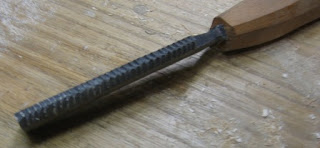Using the forge and my little trip hammer I whipped up two float blanks and a chisel. All of my previous chisel making projects involved billeting and welding up different steels -doing one high carbon billet and one low carbon. Then cutting off portions of those billets and welding the pieces together to make the chisel. However, I didn't want to invest the hours needed for this process so I made a non-laminant 5/32" chisel from one of my high carbon scraps. Just so it wouldn't be too plain-jane I gave it a somewhat 18th century style bolster. Some quality time with some files, harden, temper, hard maple handle, some work with the sharpening stones and she was good to go. This chisel has been my go-to when cleaning up the mortises for the saw backs.
The floats a bit more time since all of the teeth were filed. I saved myself a little elbow grease and my files a little wear and tear by letting the float blanks anneal in the forge when I was done.
The first float had two cutting surfaces set on 45 degree angles to clean up and or sink the bottom of the saw back mortise deeper. I chamfer the undersides of my sawbacks and this tool allows the back to fit down into the slot with no dead space. Because of the angle and the narrowness of the mortise, I would need an even smaller chisel than my 5/32 if I wanted to chisel out the chamfers in the handle, but the float is a bit more fool-proof for this manuever. The fact that it cuts the profile I want perfectly saves a lot of time that might otherwise go into paring away slivers to achieve a good fit.
 |
| Side View |
 |
| Bottom View |
The final tool I made was a float 5/32 wide for cleaning out the mortises for the square shanks on my saw screws. When I cut the teeth into this one I remembered a picture I saw from Kenneth Robert's book on American Planemakers. There was a reprint of an advertisement that showed some planemaker's floats and I had noticed one that had alternating skewed teeth. The side profile of this tool looks wicked but it is very effective.
 |
| Skewed Tooth Float |
 |
| Skewed Float on right. From planemaker Philip Chapin's Broadside reprinted in Wooden Planes in 19th Century America by Kenneth D. Roberts, 1975 |

